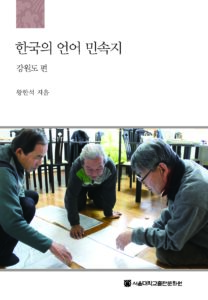
Hahn-Sok Wang 왕한석
Seoul National University Press (서울대학교출판문화원), 2021
Reviewed by Seong-in Kim (Ph.D. candidate of Seoul National University, HYI Visiting Fellow)
The Linguaculture of Gangwon Province is the fifth monograph in the Studies in Linguistic Anthropology series titled Linguistic Ethnography of Korea, published in 2021 by Emeritus Professor Hahn-Sok Wang from the Department of Anthropology at Seoul National University, South Korea. As a first-generation linguistic anthropologist who laid the foundation for the field in South Korea, Professor Wang launched this series two decades ago and continues to contribute significantly through his research and writings.
The purpose of this series is to document and analyze everyday linguistic and sociocultural practices in traditional Korean villages located in rural areas with diverse ecological environments. By focusing on cultural models from the native perspective, the series aims to illuminate the sociocultural knowledge embedded in language use, much of which is believed to have diminished due to rapid urbanization and modernization in South Korea. Based on in-depth interviews conducted over several weeks with older adults who are lifelong residents of the highland regions of Gangwon Province, as the front cover shows, this monograph provides a rich exploration of the folk knowledge inherent in their daily lives. The research addresses topics such as the villagers’ folk classifications and terminologies for ecological worlds, sociolinguistic models of kinship terms and speech levels that are uniquely developed in the Korean language, and linguistic performances, including registers and verbal arts.
A prominent theme in this monograph is the linguistic life of Gangwon Province, which reflects the deep interconnection between nature and humans. The region’s well-known harsh winters and the environment of layered mountain ranges have influenced the development of distinctive ecological and cultural knowledge among its residents. This includes their original lexical-semantic system and cultural cognition of the natural world, as well as sociocultural adaptations such as swidden agriculture, wild pig hunting, the cultivation of hemp, and the traditional practice of weaving. Readers will perceive these elements intricately woven into the unique “Linguaculture” of the villagers.
One notable highlight of the monograph is its discussion of Ararei (아라레이), a variation of Arirang Nore (아리랑 노래: Songs of Arirang), a traditional Korean folk song. Arirang, characterized by emergent variations and creativity improvised by performers, has been recognized as a UNESCO Intangible Cultural Heritage of Humanity, separately inscribed by South Korea (2012) and North Korea (2014). This study sheds light on how Ararei reflects the villagers’ subtle affections and cultural creativity. Researchers with an interest in oral folk songs and their expression of intimate emotions within traditional Korean society will find this work a valuable and engaging resource.
This monograph is not only a foundational study for understanding the linguistic and cultural traditions of Gangwon Province but also holds broader significance for researchers exploring comparative studies of traditional language and culture in Asia or examining the microhistories of everyday life during Korea’s transition to modernity with concrete linguistic data. Additionally, The Linguaculture of Gangwon Province and the broader series contribute meaningfully to the ongoing conversation about Korea’s abundant linguistic traditions and deepen our understanding of its society and culture.
